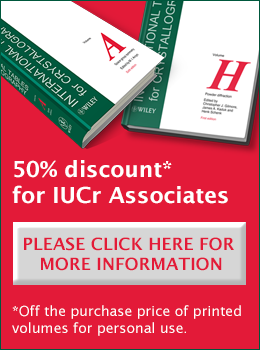
Letter from the President
President's Letter – Spring 2024
![Thumbnail [Thumbnail]](https://www.iucr.org/__data/assets/image/0006/158487/PXL_20240307_110431731.jpg)
Santiago García-Granda (front row, third from right) surrounded by IUCr staff and Journal Editors at the Journals Management Board meeting in Chester, UK, in March 2024.
As the year progresses, the IUCr is forging ahead, actively shaping its future to increase its appeal to new generations, its engagement in scientific solutions to global problems and its contribution to the maintenance and improvement of the condition of the planet, being an instrument of peace, freedom and respect for the environment.
Writing this first letter of 2024, I'm filled with optimism for the future of our Union. The recent commemoration of our 75th General Assembly, held in Melbourne, Australia, the 26th in our triennial series, was a jubilant occasion where we celebrated our illustrious history. It is important to recognise, learn from and even imitate the pioneers, but perhaps it is just as important to look to the future through the new generations, in the same way that scientific objectives have evolved from classical crystallography to all aspects of structural science, as highlighted by the theme of our next Congress and General Assembly, IUCr27 in Calgary, Canada, in August 2026: 'Embracing Structural Science'. New times call for new ways and new people, and generational change is the key factor in any organisation that intends to endure. That is why the IUCr needs to put its efforts into offering leadership opportunities to young people and integrating all structural scientists in a transversal way in our plans for scientific cooperation with the widest possible transversality.
One of the aspects that should differentiate our renewal, in the current social context, is the incorporation of female leadership in a natural way in our activity. By fostering a culture where female leadership thrives naturally, we're not just evolving; we're paving the way for a brighter, more inclusive future for all.
A second aspect is the identification of the IUCr as a global scientific organisation, with local representation through the Regional Associates and National Committees. They must have the capacity to operate with broad autonomy but have a clear identification with the global parent IUCr. Our five Regional Associates cover in a very reasonable and convenient way the five continents. It is important that all of them participate in a rational way in the leadership of the IUCr and that they strengthen the links of collaboration between them.
On the other hand, the 55 National Committees, which make up the General Assembly, should also, both through their Regional Associates and through their representation in the IUCr, make their voice heard, participate actively in the IUCr's activities and establish multinational collaborations. One of the objectives of the Executive Committee (EC) is to increase the number of National Committees to include countries where crystallography and structural science are developing so that they can contribute to the enrichment of the IUCr with their input.
The aim is to create a more cohesive image of the IUCr and also to take advantage of the capacity of the Regional Associates and the National Committees to raise awareness of the IUCr. In particular, it is important to show via social media a coherent and close image to society from a scientific analysis of the main challenges we face as a global society, and the specific effects in a community or nation or in a given geographical area.
The sustainability of resources for life on the planet – in all its diversity – is a key issue that humanity is not satisfactorily resolving. The International Year of Basic Sciences for Sustainable Development 2022/2023 (IYBSSD) has provided a new look at sustainability from a scientific point of view, and managed to capture the attention of the highest global institutions, such as the United Nations, UNESCO and the ISC, and especially, gave a voice to the new generation of scientists to address the problems and provide sustainable solutions.
The natural follow-up to the success of IYBSSD is the International Decade of Sciences for Sustainable Development (IDSSD), which was launched by the United Nations on 25 August 2023 and will run until 2033. The broad period of the Decade, beyond 2030, will allow progress to be assessed and for the SDGs (Sustainable Development Goals) to be modulated using the tools of basic science. It will also allow the integration of efforts to train new generations of scientists increasingly concerned with solving global problems, in a cross-cutting and cooperative way, and give female scientists the chance to be protagonists, contributing to and leading the paradigm shift. Structural scientists can apply their developments to environmental remediation and recovery as well as to the optimal reuse of resources or the production of clean energy, solving global environmental problems by seeking an optimal distribution of the planet's limited resources. The exploration of off-planet resources is another avenue in which the experience and knowledge of structural scientists will be extremely valuable. These people should be ready to be fully involved in changing the priorities and the way of life of humanity in the following decades.
![[Fig. 2]](https://www.iucr.org/__data/assets/image/0007/158506/Screenshot-2024-02-21-161458.jpg)
In early March, after the EC bimonthly meeting, the Journal Management Board met in Chester on 7 and 8 March, and on 11 and 12 March, the spring meeting of the Finance Committee (FC) took place in Lund, Sweden. At both meetings important decisions were taken about the most important area of activity of our Union, our 10 journals, which, as we all know, are undergoing major changes due to the influence of new forms of publishing and the emergence of new practices of publishing business. In this regard, the EC, in connection with the Editor-in-Chief and the Executive Managing Editor, is devising new ways to revitalise our publications, with initiatives such as the setting up of an independent working group to provide a vision for the future development of our publishing activity in the new environment. In parallel, the FC is analysing the impact of the publishing section on the Union's finances and the initiatives that can be implemented to strengthen the Union's funds.
![[Fig. 6]](https://www.iucr.org/__data/assets/image/0007/158533/FC1.jpg)
As announced last summer, the International Science Council (ISC) voted for its new statutes on 29 February in a virtual extraordinary General Assembly. After initial fears about their position and a unanimous action by the scientific unions, the unions – the IUCr among them – have maintained their full capacity for scientific initiative and influence at the global level and in the decisions of the ISC. Hanna Dabkowska, IUCr Immediate Past President and IUCr Representative on ISC, and I attended meetings with the ISC President on 28 February.
The Chester office is doing its job as professionally as ever, with the only recent change being the appointment of Kezia Bowman in January as a Marketing Executive. Kezia is already also doing a fantastic job settling into the role, as progress is being made towards the implementation of a customer relationship management system and a new website.
![[Fig. 1]](https://www.iucr.org/__data/assets/image/0007/158479/kb2.png)
Further to the workshop at the Melbourne Congress last August, the EC has confirmed the Purpose, Vision and Values statements and is working on a Mission statement that covers all the important issues the IUCr will deal with to achieve its Vision and Purpose. This will be circulated to members in due course. This refocussing of the Union's objectives is reinforced by a brand refresh where we are working on updating the Union's logo and colour scheme.
Furthermore, a Memorandum of Understanding has been formalised with the Organisation of Islamic Cooperation (OIC) Ministerial Standing Committee for Scientific and Technological Cooperation (COMSTECH), as a framework of cooperation. This formal framework will facilitate the organisation of joint activities and increase the mobility of young scientists and collaboration on unique scientific projects and infrastructures, with the aim of strengthening structural science research with the Islamic scientific community.
![[Fig. 5]](https://www.iucr.org/__data/assets/image/0005/158504/COMSTECH2.png)
Once again, many thanks to all those who form and make our organisation work: the Regional Associates, the IUCr Commissions and Committees, Editors, Co-editors, referees and authors of our journals, our Chester staff and all individual crystallographers, women and men. Thanks to IUCr Newsletter Editor Mike Glazer, his team and all contributors for making possible, every quarter, a new issue and for continuing to be the communication reference for our community. Many thanks to all for contributing to the sustenance and reinvention of the IUCr from anywhere in the world.
All the best!
Copyright © - All Rights Reserved - International Union of Crystallography





